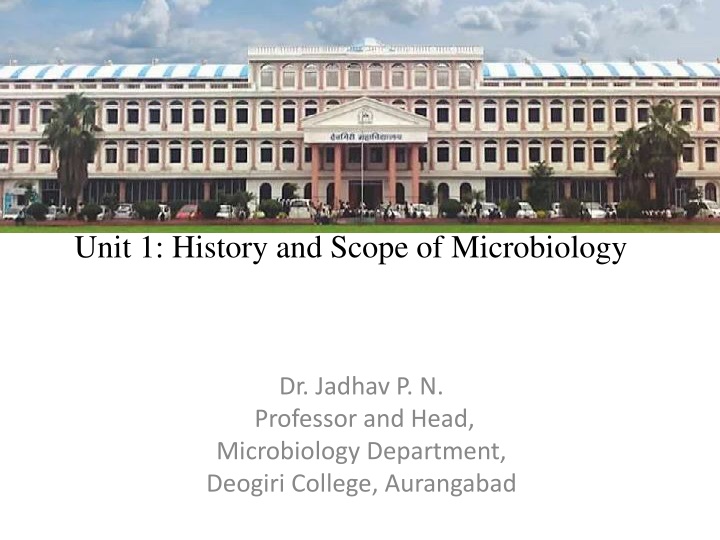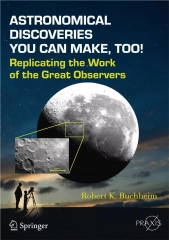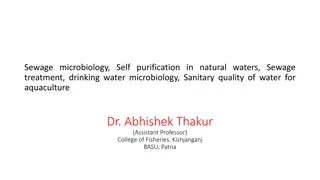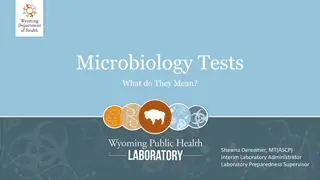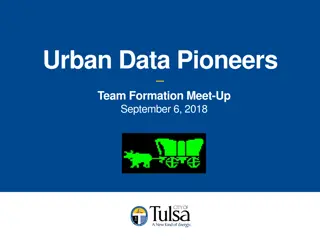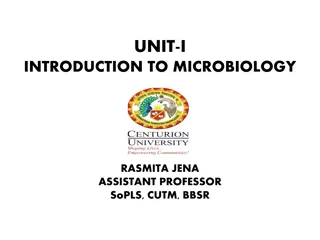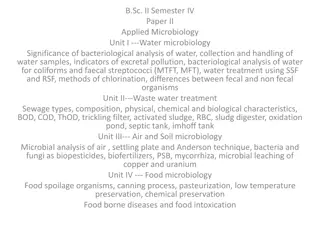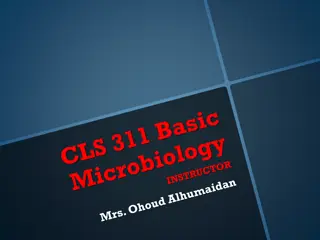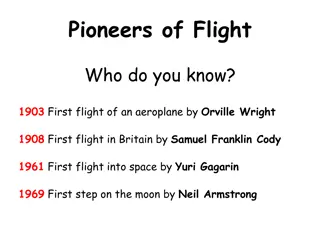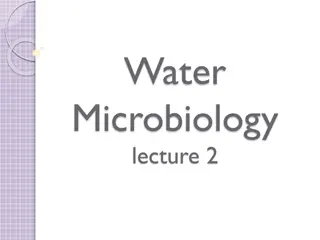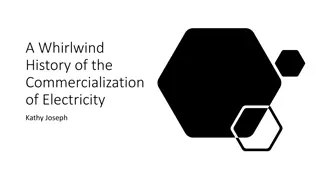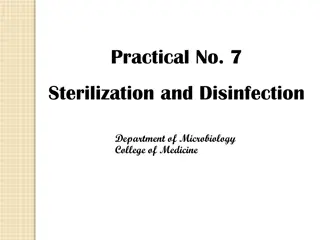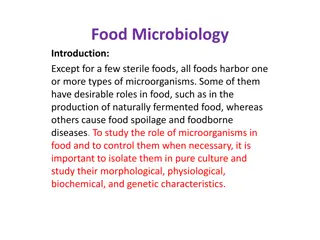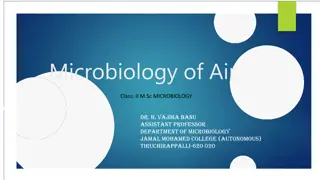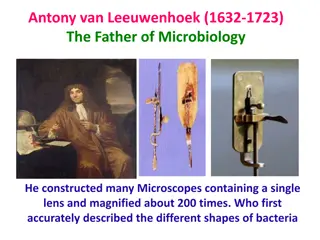History and Scope of Microbiology: Pioneers and Discoveries
The history and scope of microbiology are rich with groundbreaking discoveries by pioneers such as Louis Pasteur, Robert Koch, and Edward Jenner. From understanding the microbial role in diseases to developing vaccines, these scientists revolutionized the field. Koch's Postulates remain a foundational aspect in establishing the link between microorganisms and diseases. This historical overview sheds light on key milestones and contributions in the field of microbiology.
Download Presentation

Please find below an Image/Link to download the presentation.
The content on the website is provided AS IS for your information and personal use only. It may not be sold, licensed, or shared on other websites without obtaining consent from the author.If you encounter any issues during the download, it is possible that the publisher has removed the file from their server.
You are allowed to download the files provided on this website for personal or commercial use, subject to the condition that they are used lawfully. All files are the property of their respective owners.
The content on the website is provided AS IS for your information and personal use only. It may not be sold, licensed, or shared on other websites without obtaining consent from the author.
E N D
Presentation Transcript
B. Sc. First Year Semester I Paper I Fundamentals of Microbiology Unit 1: History and Scope of Microbiology Dr. Jadhav P. N. Professor and Head, Microbiology Department, Deogiri College, Aurangabad
B. Sc. First Year Semester I Paper I- Fundamentals of Microbiology Unit 1: History and Scope of Microbiology Dr. Jadhav P. N. Professor and Head, Microbiology Department, Deogiri College, Aurangabad
Recognition of microbial role in diseases: Oliver Holmes (1773 - 1843) showed that sepsis could be transmitted by hands of medical student and may cause disease M. J. Berkeley (ca. 1845) demonstrated that the Great Potato Blight of Ireland was caused by a Fungus Louis Pasteur (1822 - 1895) showed that the p brine disease of silkworms was caused by a protozoan parasite developed other vaccines including those for chicken cholera, anthrax, and rabies Edward Jenner (ca. 1798): Develop the first Vaccine and used a vaccination procedure to protect individuals from smallpox
Edward Jenner 1796 First vaccine (smallpox) Edward Jenner
Louis Pasteur 1885 - Vaccine against Rabies
Robert Koch (1843 - 1910) using criteria developed by his teacher, Jacob Henle (1809-1895), established the relationship between Bacillus anthracis and anthrax. His criteria became known as Koch s Postulates and are still used to establish the link between a particular microorganism and a particular disease:
Robert Koch 1884 - Koch s Postulates of Disease Transmission
Kochs Postulates: The causative (etiological) agent must be present in all affected organisms but absent in healthy individuals The agent must be capable of being isolated and cultured in pure form When the cultured agent is introduced to a healthy organism, the same disease must occur The same causative agent must be isolated again from the affected host
Pure culture concept : To enable the isolation of pure cultures (only one type of organism) Especially important during Koch s period Gelatin not useful as solidifying agent (melts at >28 C and some bacteria hydrolyze it with enzymes) Fannie Hesse, the wife of one of Koch s assistants, proposed using agar Not digested by most bacteria Melts at 100 C Used today - ~2% in solid media Richard Petri, another of Koch s assistants, developed the Petri dish
Development of Vaccines and Antisera Edward Jenner in 1796 discovered that cowpox (vaccinia) induced protection against human smallpox called procedure vaccination. Vaccination: Inoculation of healthy individuals with weakened (or attenuated) forms of microorganisms, that would otherwise cause disease, to provide protection, or active immunity from disease upon later exposure. Pasteur and Roux reported that incubating cultures longer than normal in the lab resulted in attenuated bacteria that could no longer cause disease. Working with chicken cholera (caused by Pasteurella multocida), they noticed that animals injected with attenuated cultures were resistant to the disease.
Pasteur and Chamberland developed other vaccines: Attenuated anthrax vaccine Chemical and heat treatment (potassium bichromate) Attenuated rabies vaccine Propagated the virus in rabbit following injection of infected brain and spinal cord extracts Passive immunization Work by Emil von Behring (1845-1917) and Shibasaburo Kitasato (1852- 1931). Antibodies raised to inactivated diphtheria toxin by injection different host (rabbit) with the toxin (a toxoid form). Antiserum recovered Contains antibodies specific for the toxin Protection from disease when injected non - immune subject.
JOHN TYNDALL (1820-1893) In 1876, hediscovered that there were two different types of bacteria. a) Heat sensitive or heat labile forms (vegetative cells) easily destroyed by boiling b) Heat resistant types known as an endospore Tyndall demonstrated that alternate process of heating & cooling if repeated five times, can kill all the endospores. This is known as Sterilization process or Tyndallization
FERDINAND COHN In 1876, a German botanist, Ferdinand Cohn, also discovered heat-resistant forms of bacteria . This bacteria are now termed endospores ( Bacillus species and Clostridium species).
Golden Age Of Microbiology The period from 1860 to 1900 is often named the Golden Age of Microbiology. During this period, rapid advances, spear-headed by Louis Pasteur and Robert Koch, led to the establishment of microbiology as a science. In 1864 Pasteur established the relationship between microbes and disease in preventing wine from spoiling by using the process termed pasteurization. This process kills bacteria in the alcohol by heat, thus preventing the formation of acetic acid (vinegar).
Germ Theory of Disease Louis Pasteur s discovery of pasteurization, lead him to introduce the germ theory of disease in 1864. Pasteur stated that diseases are caused by the growth of microbes in the body and not by sins, bad character, or poverty, etc.
Joseph Lister (1827 - 1912) Developed a system of surgery designed to prevent microorganisms from entering wounds phenol (Carbolic Acid) sprayed in air around surgical incision. Decreased number of post-operative infections in patients. His published findings (1867) transformed the practice of surgery.
1867 - Antiseptic Surgery by Joseph Lister( Carbolic acid- Phenol):
Robert Koch (1843 1910) In 1860 developed an elaborate technique isolate & identify specific pathogens specific diseases. He isolated the anthrax bacterium. Developed pure culture methods. Identified cause of anthrax (Bacillus anthrax) , TB (Mycobacterium tubercullosis) & cholera (Vibrio cholera). to that cause
Germ Theory Of Disease In 1876 Robert Koch proved the germ theory of disease by showing that bacteria actually caused disease. Koch established a sequence of experimental steps for directly relating a specific microbe to a specific disease called Koch s Postulates.
PAUL EHRLICH In the 1890 s Ehrlich proposed a theory of immunity in which antibodies were responsible for immunity (Antitoxin). In addition, he is known as the father of modern chemotherapy. He speculated about some magicbullet that would selectively find and destroy pathogens but not harm the host (Selective Toxicity). He also develop a staining procedure to identify tubercle bacilli.
ALEXANDER FLEMING In 1928 Fleming observed that the growth of the bacterium staphyloccus aureus was inhibited in the areas surrounding the colony of a mold that had contaminated a Petri plate. The mold was identified as Penicillium notatum, and its active compound was named penicillin.
ALEXANDER FLEMING 1929 - Discovery of Penicillin (first antibiotic) penicil
Walter Hesse (1846-1911): Used Agar as a solidifying agent to harden media. Agar is extracted from seaweeds red algae. Richard Petri (1852-1921): Used Agar dish to provide a large area to grow. Christian Gram (1853-1935): Staining method that demonstrate bacteria and distinguish between Gram positive and Gram negative bacteria.
Raymond Sabouraud ( 1890-1910): Develop culture media to study yeast and molds. Dimitri Ivanovski (1892): Tobacco mosaic virus could pass through filters used to remove bacteria. Selman Waksman (1940): Discovered a number of antibiotic such as Tetracycline and Streptomycin.
Reska (1938) First Electron Microscope The electron microscope is capable of magnifying biological specimens up to one million times. These computer enhanced images of 1. smallpox, 2. herpes simplex, and 3. mumps respectively, 150,000, 150,000 and 90,000 times. To study detail structures of viruses. are magnified,
Important Early Discoveries George W. Beadle and Edward L. Tatum (ca. 1941) Studied the relationship between genes and enzymes using the bread mold, Neurospora Precursor ornithine citrulline arginine One gene, one polypeptide hypothesis Salvadore Luria and Max Delbruck (ca. 1943) Demonstrated spontaneous gene mutations in bacteria (not directed by the environment)
Oswald T. Avery, Colin M. MacLeod, and Maclyn McCarty (1944) Following initial studies by Frederick Griffith (1928) they provided deoxyribonucleic acid (DNA) was the genetic material and carried genetic information during transformation. evidence that Worked (rough and smooth). with pneumoniae Streptococcus In the 1970s new discoveries in microbiology led to the development of recombinant DNA technology and genetic engineering.
There are two types of microorganisms: Prokaryotes : have a relatively simple morphology and lack a true membrane- bound nucleus. Eukaryotes : are morphologically complex and have a true, membrane- bound nucleus.
Organisms can be divided into five kingdoms: Monera or Procaryotae, Protista, Fungi, Animalia, and Plantae
